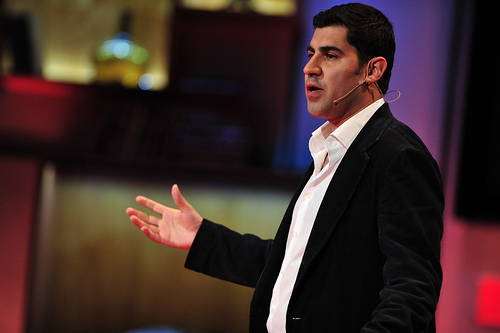
Parag Khanna asks: Do we live in a borderless world? Our world has over 200 countries. He suggests that those of us watching TED live in “TEDistan” — a world we feel is defined by cities — a world that looks like the image of the world at night from space. But for 90% of the population, that’s not true, not real. They live within borders. And often they deal with violence.
Border conflicts justify so much of the world’s military-industrial complex. This is why we need a deeper understanding of how people, money, power, religion and culture interact to change the map of the world. We need to be able to anticipate the changes that will affect where the world goes.
He starts with the world of 1945. At that time, there were about 100 nations. In the following decades, waves of de-colonization took place, adding more states. The end of the Cold War added yet more nations. The entire planet is now covered in sovereign states. But does someone’s gain have to be someone’s loss?
He shows a map featuring Russia and China. Russia is the largest country; China is the most populous. What you don’t see on a map is that most of Russia’s population is concentrated in its eastern provinces, and its population is declining by millions and millions. That population has begun to move to the west. Then there is Mongolia, what some call “Mine-golia,” sandwiched between. (China, he says, isn’t going to conquer Mongolia — it’s going to buy it, mostly in the form of mines.)
Global warming will thaw out Siberia, making it useful for farming. And in record numbers Chinese people have been “voting with their feet” by moving north, and selling the resources there back to China. But … surprise! Khanna isn’t showing a contemporary map — he’s showing a map of 700 years ago. “History doesn’t repeat itself, but it does rhyme.”
How should we look at this region in Asia? No matter what the borders tell you, what you have is hubs of commerce that form a more “fluid” sociopolitical zone. What lines on the map should we then focus on? It’s our choice, but clearly the commercial lines are really what is shaping the eventual political lines.
Khanna turns to the problem of state building. He asks us to consider Iraq. In the north, the Kurds have been waging a struggle for independence for 3,000 years. The oil pipelines in the region, since the U.S. invasion of Iraq, may finally redeem them. They are now using their control of oil pipelines as a political bargaining chip. If they control the pipelines, they can control their destiny.
What about Palestine? 30 years of rose-garden diplomacy hasn’t delivered peace. So what can supply peace? Khanna suggests infrastructure: roads, commuter rails, ports. That would allow for a viable economy, and thereby peace. Infrastructure, the curvy lines on Khanna’s map, cross the “straight lines” of the national borders.
The question in the United States is no longer “How will we use their oil?” It’s “How will they use their oil?”
Europe, to shift focus, has now become a single currency bloc, rather than disjointed individual nations. This is also shaping the future of world policy. But what is the EU’s future? Europe is divided by countries that are dependent on the rest of Europe, and those that have other connections for support.
What is the lesson? Khanna says geopolitics is an “unsentimental discipline.” It’s shaping the world — like climate change. We’re searching for equilibrium, but we also fear changes — death tolls, wars. But infrastructure is slowly bringing us toward a truly borderless world.
Photo: Parag Khanna at TEDGlobal 2009, Session 10: “Worldview rethink,” July 23, 2009, in Oxford, UK. Credit: TED / James Duncan Davidson
Comments (1)